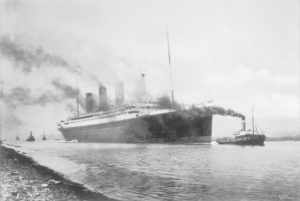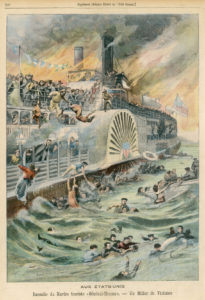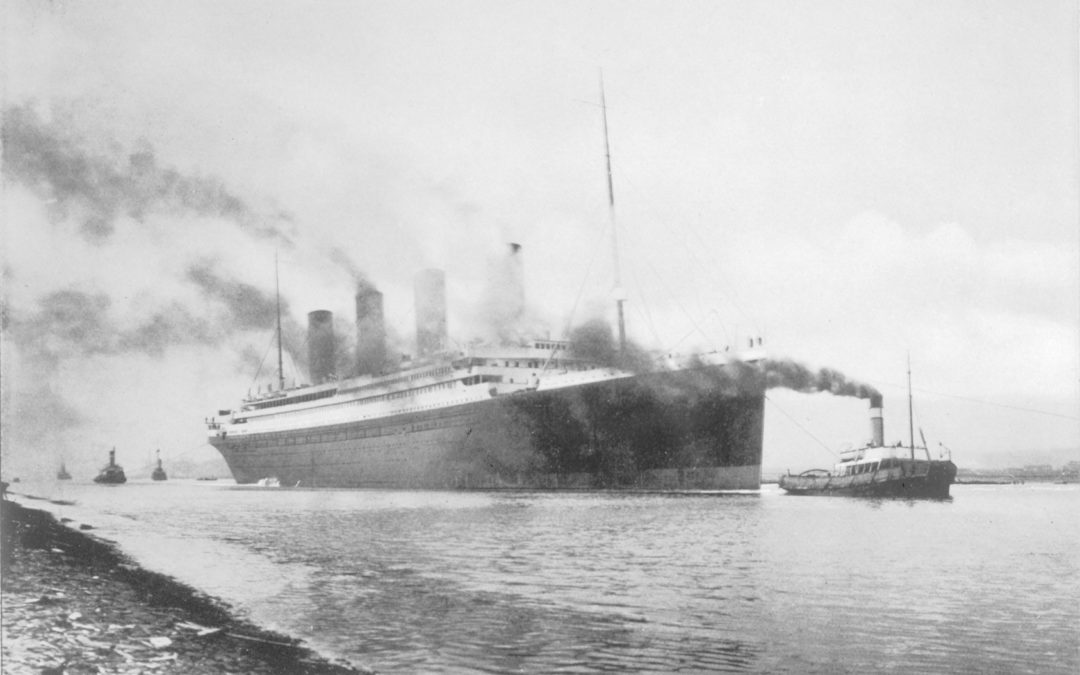For as long as people have been using wood to float on water, there have been maritime disasters. The most we can do is mourn for dead, be sensitive to the trauma of the survivors, and learn from these tragic experiences.
Let’s look at five well-known or somewhat well-known maritime disasters.
RMS Titanic
It’s been the subject of more than one film, and not just the 1997 James Cameron blockbuster. It’s even the subject of a musical (The Unsinkable Molly Brown).
But just what is it about the Titanic that captures the imagination? Part of it, surely, is the luxury of the ship and a lot of its high-class passengers. Another reason is the arrogance of referring to the ship as ‘unsinkable’. Plus the tragic loss of life has to be a part of the fascination that continues to this day.

On the fifteenth of April of 1912, the Titanic was adjusting course several times, on its maiden voyage from Southampton to New York City. The idea was to sail along an area of the northern Atlantic Ocean called ‘the corner’, where ships of the day normally would sail past Newfoundland. At the time, the ship was on course for the Nantucket Shoals Light when it hit an iceberg on the starboard side while attempting to steer around it.
At the time, ice warnings (which the Titanic did receive) were seen as advisories. Ships of the day would continue at full steam ahead. In particular, for the Titanic, timekeeping was important. There had been some incidents with iceberg collisions, but those had not been serious. Hence the prevailing thought of the day was that ice did not pose a significant danger.
Perhaps the biggest error was the fact that the ship only had lifeboats for around half of the people on board. The crew was not prepared to handle an evacuation. About 1500 people perished, and approximately 710 survived a tragedy that was, if not preventable, could have been reduced considerably if there had been enough lifeboats and a competently trained crew.
SS Edmund Fitzgerald
Without the Gordon Lightfoot song to make it famous, the SS Edmund Fitzgerald might have literally sunk into obscurity. This American Great Lakes freighter was used to haul taconite iron ore from the mines near Duluth in Minnesota to the iron works in Toledo, Detroit, and other Great Lakes port cities. More than just a workhorse, the Edmund Fitzgerald was also known for its speed. The ship set seasonal hauling records six times during its working life, which spanned from 1958 to 1975.
The captain, Peter Pulcer, was called the ‘DJ Captain’, for his habit of playing music while the ship sailed between Lakes Erie and Huron through the St. Clair and Detroit Rivers. Music was played day and night. Furthermore, Captain Pulcer would also entertain spectators between Lakes Huron and Superior at the Soo Locks, with running commentary about the vessel. As a result, the ship was well known to boat watchers.
On November 9, 1975, Captain Ernest McSorley commanded the ship on what should have been a somewhat routine run from Superior, Wisconsin (which is near Duluth) to a steel mill that was near Detroit. On that day, the Edmund Fitzgerald accompanied the SS Arthur M. Anderson, another freighter. However, the next day, both ships were caught up in a sudden storm with waves of up to 35 feet and winds that were near hurricane force. The Fitzgerald reported it was having some difficulties, but its last transmission to the Anderson said that they were holding their own.
Just after 7:10 PM, the Fitzgerald suddenly sank about 17 miles from Whitefish Bay, on the Canadian side, near Sault Ste. Marie. The Anderson searched in vain for survivors among the 29 crew members, but there were none. Along with the tragic loss of life, the sinking caused a loss of some $24 million, which was the most in Great Lakes maritime history. The widows of two crew members filed suit in American admiralty courts (while the ship sank in Canadian waters, it was subject to American admiralty jurisdiction) for $1.5 million and then later a second suit was filed for over $2 million. Both suits named Oglebay Norton Corporation, the operators of the vessel, and Northwest Mutual, its owner. Oglebay Norton ended up paying compensation to the survivors of the ship’s crew.
As a result of this tragedy, shipping practices in the Great Lakes were changed. This included the addition of LORAN (now replaced with GPS), better navigational charts, and depth finders. Crews now wear survival suits equipped with strobe lights.
F/V Andrea Gail
The fishing vessel Andrea Gail was lost at sea with all hands on October 28, 1991, in what became known as ‘the perfect storm’. This inspired the Sebastian Junger book and Mark Wahlberg film, both called The Perfect Storm. This 72 foot long commercial fishing vessel made its home in Marblehead, Massachusetts, although it would also sail out of Gloucester, which is where catches would be offloaded and supplies reloaded for future runs.
On September 20, 1991, the Andrea Gail set sail from Gloucester for the Grand Banks of Newfoundland. Captain Billy Tyne was disappointed with the fishing so he sailed east to the Flemish Cap (an area of shallow waters to the east of St. John’s, Newfoundland and Labrador). Although he received weather reports of bad conditions, Tyne set sail for home on October 26, not waiting as the catch was about to spoil, since the ship’s ice machine was not working properly.
Ocean buoy monitors reported wave heights of 39 feet, with weather buoys reporting waves of up to 60 feet. While some flotsam such as the emergency position-indicating radio beacon and an empty life raft were found near Sable Island in Nova Scotia, the wreck itself, as of the time of the writing of this blog post, has not been recovered. Educated guesses put it somewhere near the continental shelf near Sable Island.
PS General Slocum
The PS General Slocum was a passenger steamship built in 1891. On June 15, 1904, the vessel caught fire and sank in New York City’s East River. There were 1,342 people on board and an estimated 1,021 of them perished. This was the second worst disaster in American waterways in history, and it was the worst in New York City waters. It was the city’s worst disaster and biggest one-day loss of life until 9/11.
The owners did not maintain the safety equipment, including life preservers which broke apart and were weighted down with iron bars (to meet weight standards of the time), and lifeboats which were allegedly wired and painted in place. Heavy, woolen clothing dragged passengers under, and many of them could not swim (which was common for the time). Captain Van Schaick did not stop the ship under the belief that the fire (which was fed by oily rags and straw in the lamp room) would spread to the shore. Instead, his actions fanned the flames. The ship finally sank just off North Brother Island near the Bronx.
As a result of the disaster, eight people were indicted by a federal grand jury, including the captain and two inspectors. However, only the captain was convicted, and that was for criminal negligence. He was sentenced to ten years at Sing Sing. However, he served just over three years when he was paroled (President Theodore Roosevelt did not pardon him, but he was pardoned by President Taft in 1912).
SS Sultana
The SS Sultana was a side-wheel steamboat on the Mississippi River. The ship exploded on April 27, 1865, making for the worst maritime disaster in American history. At the time, because the killing of John Wilkes Booth had happened just the day before, the tragedy received less press attention than would be expected.
This wooden steamboat had the capacity to carry 376 passengers. However, at the time of the tragedy, she had 2,155 passengers on board. Three of the four ship’s boilers exploding caused the loss of the vessel. The ship burned to the waterline and sank near Memphis. 1,192 passengers lost their lives.
The Sultana was overcrowded due to greed. The captain, J. Cass Mason, was offered $5/enlisted man and $10/officer to transport freed Union prisoners of war back north. The chief quartermaster, Lt. Col. Reuben Hatch, suggested the ship could hold 1,400 passengers, in exchange for a kickback. However, due to a mix-up, the Sultana took on even more passengers. In addition, knowing he would lose his passengers if there was a delay, Captain Mason had a dangerous bulged boilerplate improperly prepared, as that would be faster.
The passengers had been POWs at Cahaba in Alabama and the notorious Andersonville prison, and they were generally in weakened conditions. They were packed into every available space on board. The ship sailed upriver for two days, fighting some of the worst spring flooding in the river’s history, when the boilers exploded at about 2 AM on the 27th. The explosion completely destroyed the pilothouse, so the burning ship had no steering.Passengers, already weak, flung themselves overboard and had to deal with the icy waters of the river. Many drowned or died from hypothermia. Captain Mason went down with the ship.
No one was truly held accountable for the tragedy. Captain Frederic Speed, a Union officer who sent virtually all of the Union prisoners from a parole camp onto the Sultana was convicted of grossly overcrowding the ship but his conviction was overturned as he was at the camp that day and had not actually placed any soldiers aboard. Hatch had quickly quit the military and could no longer be subject to the jurisdiction of military courts. Due to corruption, and having highly-placed patrons, Hatch escaped justice entirely.
Because the Mississippi River has changed course several times since the disaster, the remains of the ship are apparently on dry land. Remnants which appeared to be from the Sultana were uncovered in 1982.
In all of these tragedies, there were things that could have been done differently, in order to minimize loss of life. Sea captains, ship owners, and governments would do well to study these tragedies and learn more about how to prevent them in the future.

